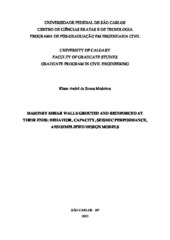Paredes de contraventamento de alvenaria grauteadas e armadas nas extremidades: comportamento, capacidade, desempenho sísmico e modelos simplificados de projeto
Abstract
Partially grouted masonry structures are widely used worldwide, preferably in regions with low and mid-intensity wind and seismic loads. Thus, this thesis focuses on partially grouted masonry walls (PGMW), especially those with grout and reinforcement placed at their ends. The objectives were to evaluate the in-plane behavior, capacity, and seismic performance of multi-story coupled masonry walls, and to assess simplified design models. The thesis is divided into four parts.
In the first part, finite element (FE) models were developed to assess the influence of several parameters on the load capacity, deflection, and initial stiffness of multi-story PGMW with openings. The base model was validated with experimental data from three walls tested previously by the research group. The analyses indicated that the load capacity of masonry walls was sensitive to the ungrouted and grouted masonry strengths, mortar shear strength, vertical reinforcement ratio, aspect ratio, and axial stress; and almost insensitive to the opening size, reinforcement spacing, and horizontal reinforcement ratio. The deflection of the walls had well-defined correlations with the masonry strength, vertical reinforcement, axial stress, and aspect ratio. The initial stiffness was especially sensitive to the axial stress and the aspect ratio, but weakly correlated with the opening size, and the spacing and size of the reinforcement.
In the second part, relevant existing shear equations, including the equations of the TMS 402/602 (2016) and the CSA S304 (2014), were evaluated, and a new equation was proposed. Also, different approaches were examined to determine the most consistent method of predicting the shear load capacity (SLC) of single and multi-story PGMW with openings. The database used in this study comprises ninety-six masonry walls created using the previously developed FE model, which was adjusted and recalibrated, and fifty-nine experimental masonry walls reported in the literature. The statistical analysis showed that the new proposed equation performed more precisely than the other shear equations and highlighted the need of updating the expressions in TMS 402/602 (2016) and the CSA S304 (2014) since those equations made the most inaccurate predictions of those assessed. The results confirm that is unsafe to calculate the SLC of a wall ignoring the openings. The most accurate predictions for the perforated walls were obtained using the proposed equation considering the strength of the wall as the sum of the strength of the wall piers with dimensions defined by the openings of the same story.
The third part focused on evaluating the in-plane behavior and seismic performance of multi-story perforated PGMW with grout and reinforcement placed at the ends. The FE model was further validated against more specific data from the previous experimental tests. Besides two traditional bilinear idealizations for the actual wall response, a trilinear approach was presented with deduced equations for the seismic performance factors (SPFs). Results demonstrated that the reinforced masonry beam over the openings effectively coupled the wall piers yielding a frame-type behavior. Also, the results suggest that the walls behaved as a continuous frame, with the grouted parts acting like columns and the ungrouted parts acting like confined masonry. The loss of ductility evidenced in the backbone curves and the decrease of the SPFs confirmed that a high vertical pre-compression led the walls to a brittle response while also increasing the lateral load capacity. Concentrating the grouting and reinforcement at the wall pier ends showed a similar detailing design efficiency compared to distributing them along the wall piers. The stiffness degradation was more intense when the walls were subjected to a lower pre-compression level. Furthermore, the stiffness degradation curves were best fitted with power and logarithmic functions for walls with the lower and higher axial load, respectively.
In the fourth part, linear and non-linear frame models were assessed in simulating the in-plane load-displacement response of multi-story, perforated PGMW. Different configurations of linear frame models were assessed for replicating the initial lateral stiffness of the walls: additional involvement of SPFs and ultimate top drift limits enabled assessment of prediction of an idealized load-displacement response. Also, a new non-linear frame model approach was evaluated to simulate the actual load-displacement response of the walls. Results indicated that including rigid offsets on the horizontal and vertical elements of the portal frame model resulted in an initial lateral stiffness close to that of experimental walls. It was possible to reproduce the idealized lateral response of the walls using the initial lateral stiffness of the linear models associated with adequate SPFs and ultimate top drifts. The idealized curves better matched the actual response when the lateral stiffness of the linear models was closer to that of the reference walls. An imposed ultimate drift higher than the actual amplified the estimation of the lateral load capacity and vice-versa, using all the approaches assessed. Values of 0.4% and 0.2% for the ultimate top drifts proved to be reasonable options for the cases in which the walls were submitted to a pre-compression of 0.04fm' and 0.2fm', respectively. Furthermore, the proposed non-linear braced frame model could predict the envelope curves of the experimental walls up to the peak load but did not present the expected strength degradation in the post-peak stage.
Collections
The following license files are associated with this item:

